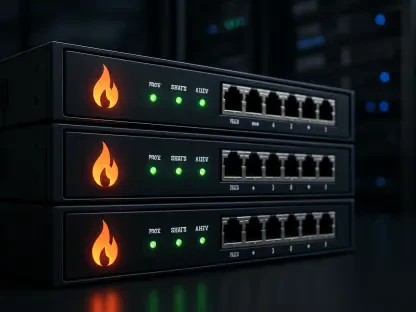The global network infrastructure market is rapidly evolving, with projections indicating significant growth in various sectors by 2028. This growth is driven by increasing demand for faster, more efficient, and more secure network services across a wide range of industries. Network planners and managers are grappling with the challenge of keeping pace with technological advancements and meeting growing business demands despite limited budget increases. In this dynamic landscape, network managers must strategically advocate for necessary upgrades by focusing on both the total cost of ownership (TCO) and the business opportunity costs associated with potential delays or cancellations of network investments.
The Drivers of Network Upgrades
Technological advancements like Wi-Fi 6 and Wi-Fi 7 are leading the charge in providing faster network services and accommodating an increasing number of devices with unique IP addresses. These innovations are revolutionizing the connectivity landscape, enabling more efficient data transmission and supporting the growing needs of modern-day businesses. Meanwhile, the proliferation of edge computing is transforming operations across various sectors, from manufacturing to retail, by enabling real-time data processing closer to the source. Additionally, cloud-based network management and security solutions are becoming indispensable as they facilitate the creation of hybrid networks that combine on-premises and cloud-based resources, offering improved scalability and flexibility.
While these technologies offer numerous benefits, their successful implementation requires a competent and skilled workforce. Consequently, network managers face the pressing task of either recruiting new talent or training existing staff to manage and operate these advanced systems efficiently. As network managers embark on this journey, they must be prepared to justify the associated investments to higher management by demonstrating their value and necessity. This involves not only highlighting the immediate gains from adopting cutting-edge technologies but also underscoring the long-term strategic advantages that these investments will bring to the organization.
Addressing TCO Concerns
Network managers often face critical questions from C-level executives, such as the CIO, CFO, or CEO, regarding the total cost of ownership for new technology investments. Traditionally, calculating network TCO involves summing up costs for network hardware, software, staff labor, contractor labor, service contracts, power consumption, and floor space, followed by estimates for operating expenses and asset capitalizations. However, this phased approach may not be sustainable given the urgent need for investments in edge computing, rapid information transport, heightened security, and comprehensive network monitoring. The rapid evolution of technology means that incremental upgrades may fall short of meeting the growing demands of modern businesses.
To effectively navigate this new TCO landscape, the conversation must shift from mere cost justification to a thorough evaluation of the opportunity costs for the business if network infrastructure investments are delayed or canceled. Opportunity costs represent the potential losses a business may incur by forgoing essential upgrades, which could lead to operational inefficiencies, security vulnerabilities, and missed growth opportunities. Network managers must, therefore, emphasize the broader business implications of their proposals and articulate how strategic investments in network technology can drive long-term sustainability and growth.
The Role of Opportunity Costs
Opportunity costs are a critical consideration when evaluating network investments, as they highlight the potential losses a business may face by failing to invest in necessary upgrades. For example, a company aiming to decentralize its operations without increasing headcount would benefit immensely from edge computing and network automation. Such technologies enable seamless communication and data processing across distributed locations, ensuring that decentralized operations run smoothly and efficiently. Additionally, robust security measures, such as zero-trust networks and observability software, are essential for maintaining consistent enterprise security across remote sites. These solutions mitigate the risks associated with decentralized operations by providing real-time visibility and control over network activities.
In these scenarios, advocating for network technology investments should involve a collaborative effort among multiple stakeholders, including the COO, VP of operations, and HR, alongside the CIO and network manager. This collective approach ensures that network investments are aligned with broader corporate strategies and receive the necessary support from key decision-makers. By framing network upgrades as a strategic imperative that addresses both operational needs and long-term business goals, network managers can build a compelling case for securing funding and resources.
Linking Investments to Business Opportunities
Network managers must link funding proposals to business opportunities and the accompanying opportunity costs if such investments are denied. For instance, moving IT to the cloud is often favored for its cost-effectiveness, resulting in hybrid networks that combine cloud-based and internal resources. This strategic move allows organizations to leverage the scalability and flexibility of cloud services while maintaining control over critical on-premises infrastructure. Ensuring airtight security is crucial to prevent data breaches and intellectual property theft, which could have severe financial and reputational consequences for the business. Although many companies use IAM (Identity and Access Management) systems for unified user access management, CIEM (Cloud Infrastructure Entitlement Management) software offers greater security visibility and granularity. However, the high costs associated with CIEM necessitate traditional TCO discussions, emphasizing the risks and costs of inadequate cloud-based security.
Network managers must effectively communicate the strategic benefits of these investments by highlighting the potential business opportunities that could be realized through enhanced network capabilities. For example, improved network performance and security can drive innovation, enabling the development of new products and services that meet evolving customer demands. Additionally, robust network infrastructure can enhance operational efficiency, reduce downtime, and support the company’s long-term growth objectives.
Overcoming Budget Limitations
Network managers face annual budget limitations while striving to upgrade networks. The traditional TCO justification and payback discussions often fail to garner value recognition from others. To overcome this, network managers must present the business opportunity costs if proposals are declined or deferred, with support from managers advocating for corporate strategies requiring network infrastructure investment. This approach helps secure necessary funding by highlighting the strategic benefits and potential losses associated with delaying or canceling network investments.
To make a compelling case, network managers should use real-world examples and case studies that demonstrate the positive impact of similar investments in other organizations. By showcasing concrete evidence of the value and returns generated from network upgrades, they can build a stronger argument for securing funding and resources. Additionally, network managers should seek to foster a collaborative environment where key stakeholders are actively engaged in the decision-making process, ensuring that network investments are aligned with the company’s overarching goals and objectives.
Integrating Network Infrastructure into Corporate Strategy
The global network infrastructure market is experiencing rapid changes, with significant growth expected across various sectors by 2028. This surge is largely due to the rising demand for faster, more efficient, and highly secure network services across diverse industries. Network planners and managers face the ongoing challenge of staying ahead in terms of technological advancements and addressing increased business requirements, all while managing limited budget expansions. Within this dynamic environment, network managers need to strategically advocate for necessary enhancements by emphasizing the importance of both the total cost of ownership (TCO) and the business opportunity costs that may arise from potential delays or cancellations of network investments. By carefully considering these factors, they can present a compelling case for upgrades that align with their organization’s long-term goals and competitive advantage, ensuring that they continue to meet the growing demands of the digital age effectively.









